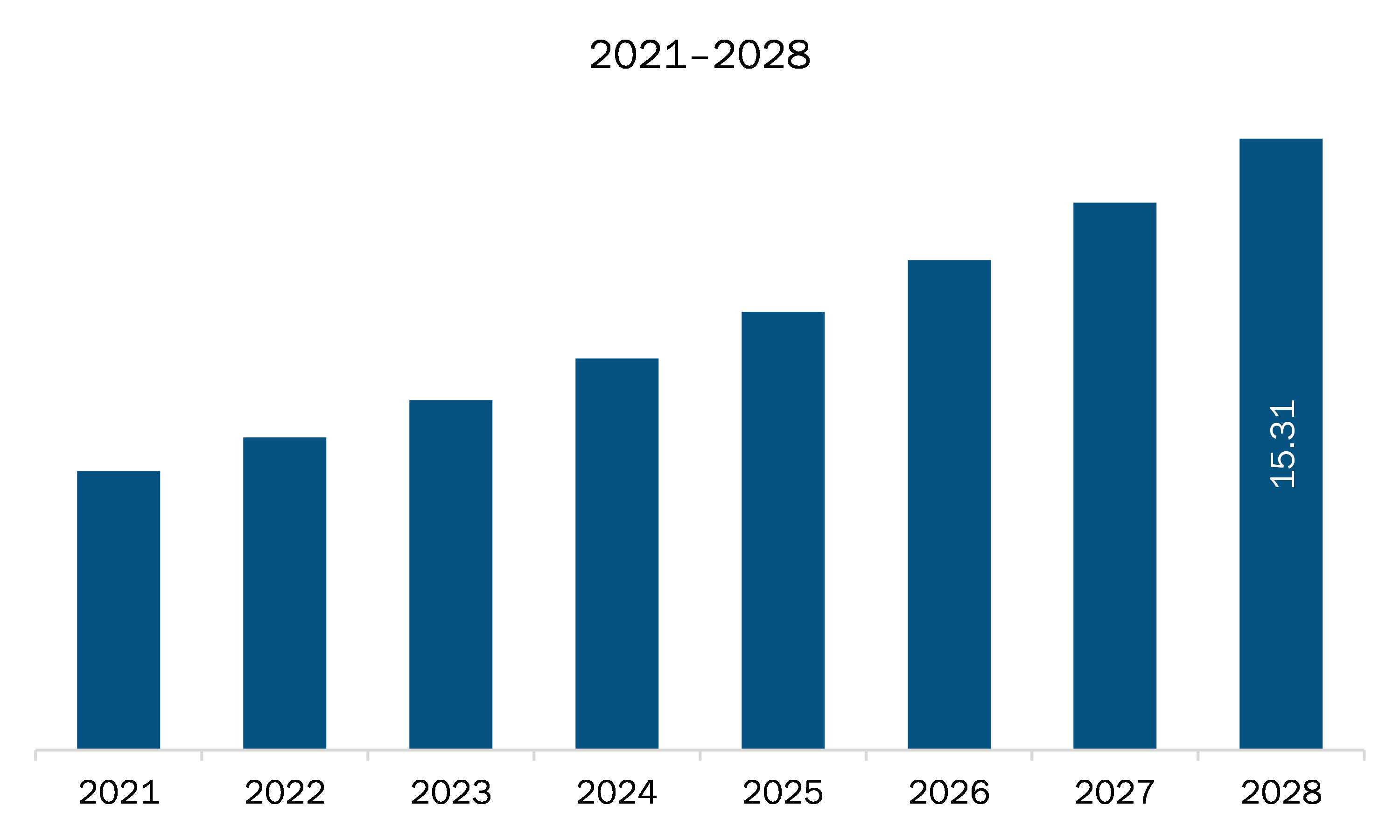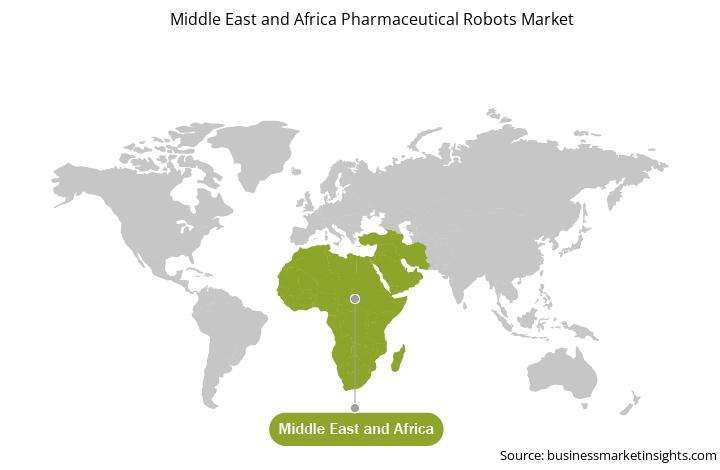The Middle East and Africa pharmaceutical robots market is a highly fragmented market with the presence of considerable regional and local players providing numerous solutions for companies investing in the market arena. Cloud robotics is an emerging field of robotics rooted in cloud computing, cloud storage, and other Internet technologies centered on the benefits of converged infrastructure and shared services. Connecting robots to the cloud increase computational power, storage, and communications. Cloud robots communicate with each other and thus operations are carried out easily. The Google Cloud Robotics Platform combines AI, robotics, and the cloud to enable the opening of an ecosystem of automation solutions that use cloud-connected collaborative robots. Along with AI and machine learning services, the robots will be able to efficiently carry out processes in highly dynamic environments in the manufacturing industry. Moreover, in the industry, the cloud is an ally for processing a large amount of data. Cloud-based software, with appropriate security protocols, can be adopted to facilitate integration and automation. Its use helps reduce the paperwork of the companies, making data manageable. Thus, cloud robotics is expected to become the trend in the pharmaceutical robot market in the future.
The COVID-19 has shown substantial effects in Middle East and Africa. The pandemic has increased the demand of pharmaceutical robots. Countries such as UAE, and Saudi Arabia have also registered a significant number of positive patients. These regions are developing in terms of the medical industry. The countries in these regions are highly dependent on medical devices and biopharmaceuticals products. Following COVID-19 and government actions, certain pharmaceutical robot applications, such as in healthcare sectors, are likely to see an increase in demand. The increasing demand of pharmaceutical robot for detection of virus in medical research and diagnostics has been a major factor in the growth of the market in Middle East & Africa region. The region has observed increasing numbers of patients are being admitted to intensive care units (ICU), rising number of medications imposing multiple diagnostic and therapeutic challenges on stressed healthcare systems and leading to rise in medication errors which can be controlled through the adoption of pharmaceutical robots in the scenario. Thus, rising in intensive care units (ICU) admissions during COVID 19 and this is likely to boost the growth of pharmaceutical robot market.

Strategic insights for the Middle East and Africa Pharmaceutical Robots provides data-driven analysis of the industry landscape, including current trends, key players, and regional nuances. These insights offer actionable recommendations, enabling readers to differentiate themselves from competitors by identifying untapped segments or developing unique value propositions. Leveraging data analytics, these insights help industry players anticipate the market shifts, whether investors, manufacturers, or other stakeholders. A future-oriented perspective is essential, helping stakeholders anticipate market shifts and position themselves for long-term success in this dynamic region. Ultimately, effective strategic insights empower readers to make informed decisions that drive profitability and achieve their business objectives within the market.

| Report Attribute | Details |
|---|---|
| Market size in 2021 | US$ 6.99 Million |
| Market Size by 2028 | US$ 15.31 Million |
| Global CAGR (2021 - 2028) | 11.9% |
| Historical Data | 2019-2020 |
| Forecast period | 2022-2028 |
| Segments Covered |
By Product
|
| Regions and Countries Covered | Middle East and Africa
|
| Market leaders and key company profiles |
The geographic scope of the Middle East and Africa Pharmaceutical Robots refers to the specific areas in which a business operates and competes. Understanding local distinctions, such as diverse consumer preferences (e.g., demand for specific plug types or battery backup durations), varying economic conditions, and regulatory environments, is crucial for tailoring strategies to specific markets. Businesses can expand their reach by identifying underserved areas or adapting their offerings to meet local demands. A clear market focus allows for more effective resource allocation, targeted marketing campaigns, and better positioning against local competitors, ultimately driving growth in those targeted areas.

The pharmaceutical robots market in Middle East and Africa is expected to grow from US$ 6.99 million in 2021 to US$ 15.31 million by 2028; it is estimated to grow at a CAGR of 11.9% from 2021 to 2028. In recent years, there have been considerable developments in the field of robotics. Robotics offers automation in various pharmaceutical manufacturing processes, such as filling, packaging, and inspection. A few benefits of automation in pharmaceutical manufacturing are improving efficiency in manufacturing, decreasing labor cost, reducing time used for training labors, protecting employees from a hazardous environment, and eliminating the chances of human errors and human contamination. Selective Compliance Assembly Robot Arm (SCARA) robots are used for common pick and place operations. Delta robots are also preferred for high-speed picking and packaging. Parallel robots are used for dispensing, kit assembly, sorting, and light machine tending applications. The pharmaceutical industry has realized the potential of robots for diverse applications in the manufacturing process. Pharmaceutical company benefits from robotic process automation (RPA) because it assists management in formulating strategies in real-time based on consumption trends and other regulatory changes. Thus, the use of robots in the pharmaceutical industry helps improve the overall product quality and speeds up the entire process of production, which enables the industry to meet the ever-growing demand for new drugs. Hence, the benefits offered by robots in the pharmaceutical industry drive the growth of the Middle East and Africa pharmaceutical robots market.
Based on product, the traditional robots segment accounted for the largest share of the Middle East and Africa pharmaceutical robots market in 2021. Based on application, the picking and packaging segment accounted for the largest share of the Middle East and Africa pharmaceutical robots market in 2021. Based on end user, the pharmaceutical companies segment accounted for the largest share of the Middle East and Africa pharmaceutical robots market in 2021.
A few major primary and secondary sources referred to for preparing this report on the Middle East and Africa pharmaceutical robots market are company websites, annual reports, financial reports, national government documents, and statistical database, among others. Major companies listed in the report include ABB, Kawasaki Heavy Industries, Ltd., Yaskawa Electric Corporation, Marchesini Group S.p.A, Denso Corporation, Fanuc Corporation, and Seiko Epson Corporation.
The Middle East and Africa Pharmaceutical Robots Market is valued at US$ 6.99 Million in 2021, it is projected to reach US$ 15.31 Million by 2028.
As per our report Middle East and Africa Pharmaceutical Robots Market, the market size is valued at US$ 6.99 Million in 2021, projecting it to reach US$ 15.31 Million by 2028. This translates to a CAGR of approximately 11.9% during the forecast period.
The Middle East and Africa Pharmaceutical Robots Market report typically cover these key segments-
The historic period, base year, and forecast period can vary slightly depending on the specific market research report. However, for the Middle East and Africa Pharmaceutical Robots Market report:
The Middle East and Africa Pharmaceutical Robots Market is populated by several key players, each contributing to its growth and innovation. Some of the major players include:
The Middle East and Africa Pharmaceutical Robots Market report is valuable for diverse stakeholders, including:
Essentially, anyone involved in or considering involvement in the Middle East and Africa Pharmaceutical Robots Market value chain can benefit from the information contained in a comprehensive market report.